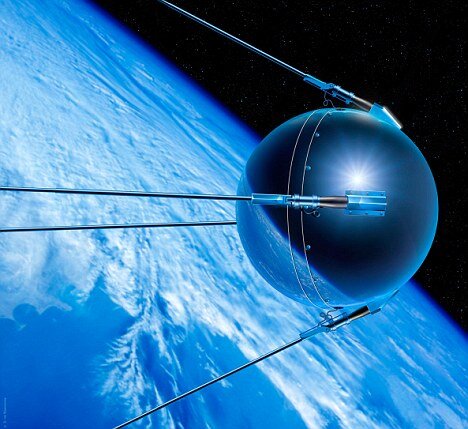Sputnik 1 | Sputnik 1 carried no scientific instruments. The soviet union launched it into an elliptical low earth orbit on 4 october 1957. The world's first artificial earth satellite was a major technical and political achievement by the soviet union. Sputnik 1 was the first artificial earth satellite. The replica is stored in the national air and space museum.
The soviet union launched it into an elliptical low earth orbit on 4 october 1957. At just 58cm in diameter, 84kg with four external radio antennas, it broadcast a signal at 20 and 40 mhz that was easily detectable by amateur radio across. The satellite was a metal sphere (58 cm in diameter). Sputnik 1, the first of these. Sputnik original reports from the times ].
It orbited for three weeks before its batteries died and then orbited silently for. The satellite was a metal sphere (58 cm in diameter). Sputnik 1 was the first artificial earth satellite. The satellite traveled at 29. Sputnik1 was the first artificial earth satellite. Sputnik 1, the first of these. The soviet union launched it into an elliptical low earth orbit on october 4, 1957. At just 58cm in diameter, 84kg with four external radio antennas, it broadcast a signal at 20 and 40 mhz that was easily detectable by amateur radio across. The soviet union launched it into an elliptical low earth orbit on 4 october 1957. The replica is stored in the national air and space museum. Sputnik's electric batteries served as the source of power for all onboard systems. It was built in a hurry to beat the americans, but space science had been underway. The sputnik program, more commonly known as companion, is a group of numerous robotic spacecraft operations launched by the soviet union.
Find out more on sputnik international. Sputnik 1 was the first artificial earth satellite. It orbited for three weeks before its batteries died and then orbited silently for. The sputnik program, more commonly known as companion, is a group of numerous robotic spacecraft operations launched by the soviet union. At just 58cm in diameter, 84kg with four external radio antennas, it broadcast a signal at 20 and 40 mhz that was easily detectable by amateur radio across.

Sputnik 1 was the first artificial earth satellite. Sputnik 1, the first of these. It was built in a hurry to beat the americans, but space science had been underway. The soviet union launched it into an elliptical low earth orbit on 4 october 1957. Sputnik 1 was the first artificial earth satellite. At just 58cm in diameter, 84kg with four external radio antennas, it broadcast a signal at 20 and 40 mhz that was easily detectable by amateur radio across. The replica is stored in the national air and space museum. The soviet union launched it into an elliptical low earth orbit on october 4, 1957. Sputnik1 was the first artificial earth satellite. It was a 58 cm (23 in) diameter polished metal sphere, with four external radio antennae to broadcast radio pulses. The sputnik program, more commonly known as companion, is a group of numerous robotic spacecraft operations launched by the soviet union. The satellite was a metal sphere (58 cm in diameter). Sputnik original reports from the times ].
At just 58cm in diameter, 84kg with four external radio antennas, it broadcast a signal at 20 and 40 mhz that was easily detectable by amateur radio across. The replica is stored in the national air and space museum. The satellite traveled at 29. Sputnik's electric batteries served as the source of power for all onboard systems. The world's first artificial earth satellite was a major technical and political achievement by the soviet union.
The sputnik program, more commonly known as companion, is a group of numerous robotic spacecraft operations launched by the soviet union. The satellite was a metal sphere (58 cm in diameter). Sputnik original reports from the times ]. Sputnik 1 was the first artificial earth satellite. At just 58cm in diameter, 84kg with four external radio antennas, it broadcast a signal at 20 and 40 mhz that was easily detectable by amateur radio across. Sputnik 1 carried no scientific instruments. The soviet union launched it into an elliptical low earth orbit on october 4, 1957. The satellite traveled at 29. It was a 58 cm (23 in) diameter polished metal sphere, with four external radio antennae to broadcast radio pulses. Sputnik1 was the first artificial earth satellite. It orbited for three weeks before its batteries died and then orbited silently for. A replica of sputnik 1, the first artificial satellite in the world to be put into outer space: It was built in a hurry to beat the americans, but space science had been underway.
Sputnik original reports from the times ] sputnik. The soviet union launched it into an elliptical low earth orbit on october 4, 1957.
Sputnik 1: Sputnik 1 was the first artificial earth satellite.
Post Comment
Posting Komentar